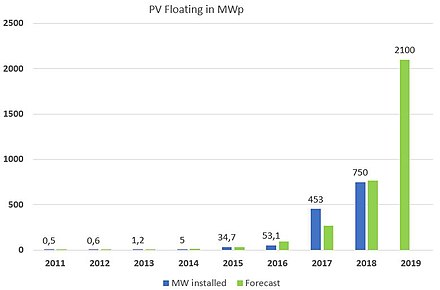Floating solar, or floating photovoltaic (FPV), simply refers to an array of solar modules floating upon a body of water. The solar panels are racked on a buoyant structure to keep them above the water’s surface and are usually located on relatively calmer bodies of water such as ponds, lakes and artificial dam reservoirs.

Photo Source: Akuo Energy
History
American, Danish, French, Italian and Japanese nationals were the first to register patents for floating solar. In Italy, the first registered patent, regarding PV modules on water, goes back to February 2008.[13]
The MIRARCO (Mining Innovation Rehabilitation and Applied Research Corporation Ontario, CANADA) research group quotes several solutions that were put forward in the years 2008-2011 and 2012-2014.[1] Without being exhaustive the installations can be classified into three categories:
- PV plants constituted by modules mounted on pontoons
- Solar modules mounted on rafts built-in plastic and galvanized steel
- PV modules mounted on rafts, fully in plastic.
It is impossible to give a detailed analysis of the many small PV floating plants built in the first 10 years. The plot below is based on data taken from the web for FPV with more than 500KW of power.
At the Asian Clean Energy Summit in Singapore (Oct. 2017) two numbers were quoted by the World- Bank Group: 453 MWp for installation in 2017 and a forecast of 750 MWp for 2018.
The graph below shows the growth of solar floating installations globally from 2011 to 2019.

Data taken from “Where Sun Meets Water: Floating Solar Market Report,” World Bank Group and SERIS, Singapore, 2018.
Advantages of Floating Photovoltaic (FPV)
One of the several advantages of FPV is that it does not occupy the land, that could otherwise be used for agricultural or forestry purposes because it eliminates the need for removal of vegetation resulting in the preservation of entire flora and fauna habitats. There is also almost no risk of shading caused by nearby trees and structures.
The floating mounting/racking structure provides shade on the water surface, reducing evaporation and water loss in hot summer months, resulting in lower water temperatures, which are a lot less susceptible to harmful algal blooms. The water body has a cooling effect on the array and BOS equipment, which is good for efficiency, as high temperatures decrease solar panel performance.
Disadvantages of Floating Photovoltaic (FPV)
FPV installations are more costly than land-based solutions due to specialized equipment needed, although costs are expected to drop with further developments in technology. Also, the majority of FPV are larger in scale, making them suitable for communities, utility companies and municipalities, but not ideal for individual households.
The future of Floating Photovoltaic (FPV)
Floating solar installations have started to spread throughout Australia, Japan, Europe and South Asia. Japan, in particular, is looking to renewable energy as an alternative for nuclear energy and has a potential 3-GW capacity through FPV alone.
FPV technology is also useful because of its potential impact in complementing hydropower when installing in artificial dam reservoirs. During seasons of rain and water abundance, hydropower is at the forefront, while summertime and low water levels are more favourable for solar power. The world’s first combined hydro and FPV power plant is in the Alto Rabagao Dam reservoir in Portugal and became operational in 2017.
While it is theoretically possible to install FPV in seas and oceans, the harsh and violent conditions have so far limited their development.
Whereas hydropower accounts for 53% of all operational renewable energy sources worldwide, wind power has a 24% share and solar power is at 18%. The International Energy Agency has named solar energy as the fastest growing renewable energy source, and the World Bank foresees rapid growth of Floating Photovoltaic Systems within the next 20 years. These trends indicate that FPV is here to stay.
References
- https://www.solarpowerworldonline.com/2019/07/will-floating-solar-arrays-float-or-sink/
- https://energyindustryreview.com/renewables/europes-largest-floating-solar-system-to-be-powered-by-17mw-of-pv-modules/
- https://en.wikipedia.org/wiki/Floating_solar
Written by Raphael George
